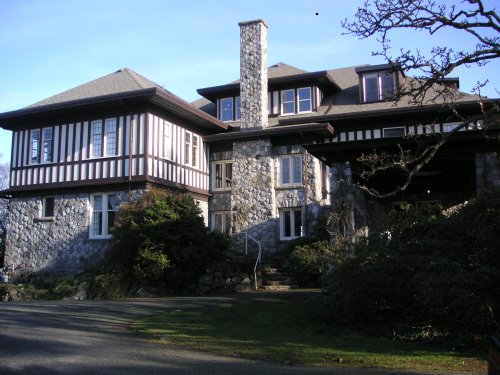931 Foul Bay Road


Located on the Foul Bay escarpment in a residential area, ‘Kildonan’ is an imposing Arts and Crafts/Tudor Revival style two-and-one-half-storey residence (three-and-one-half at the rear) with full basement. It is set in a mature, sloped landscape within a series of terraced rockeries. It is approached by a curving drive off the east side of Foul Bay Road.
‘Kildonan’, built in 1913, is valued as an outstanding representative of Tudor Revival/Arts and Crafts architecture, a residential style popular in the early part of the twentieth century, particularly in Victoria where British connections were strong. Distinguishing elements of this style exhibited at this site include the multi-hipped roof, and the rich textural change in exterior materials with the stone foundation, stucco and half timbered upper storeys, and prominent granite chimneys. The main floor is built of hexagonal stones, reportedly installed by Scottish stonemasons. A large porte-cochère leads to the double-height panelled entrance hall with bowed balcony and grand staircase. The interior panelling is made from Australian and African wood, and a local firm crafted the extensive plaster mouldings.
This site is significant as one of the finest works of its architect, Samuel Maclure (1860–1929) who is closely identified with the predominantly British Arts and Crafts style of the domestic architecture he designed for prominent businessmen on Vancouver Island and the Lower Mainland. His reputation for designing exceptionally beautiful homes led to his largest commission, Hatley Park (1907) in nearby Colwood, now a National Historic Site (1995). Maclure gained international recognition during his forty-year career, with close to five hundred commissions, many of them in Oak Bay; including neighbouring 'Tor Lodge' and 'Foreen'. Maclure utilized many stylistic influences and was able to adapt his use of indigenous materials with versatility. Many of his buildings with their handsome and functional interiors have been recognized as masterworks and are considered part of the cultural heritage of BC.
‘Kildonan’ is valued for its association with Roderick Ross Sutherland, for whom it was built; and with Hungarian Count Albert de Mezey, a subsequent owner. Sutherland was a wealthy lawyer and stockbroker from Kildonan, Manitoba who became the Vice-President of the then Trust Company of Victoria Ltd. After the Second World War, during which the house was used as women’s barracks for the RCAF, the property was purchased by Count Albert de Mezey - a renowned rhododendron and orchid breeder known for his collection of rare rock and alpine plants. He was a friend and mentor to many gardening enthusiasts, most famously Peggy Abkhazi, and it is believed that some of the rhododendrons in her garden came as cuttings from de Mezey. A philanthropist throughout his life, in the late 1980s he donated ‘Kildonan’ to the Abbeyfield Society to be used as a registered non-profit retirement home.
‘Kildonan’ reflects the evolving needs of the community over time, as demonstrated by its occupants. It was one of the 1,500 houses built in Oak Bay between 1910 and 1913 prior to the onset of the First World War at a time when the area was experiencing a boom in residential construction and an optimal business climate, attracting large architectural commissions for wealthy clients. ‘Kildonan’ is an important component of Foul Bay Road cluster of contemporaneous heritage homes built for affluent professional clients during the building boom of before the First World War. It is a fine example of heritage preservation through adaptation to changing economic circumstances - from luxury mansion to wartime barracks and finally as an Abbeyfield home for seniors, a use which is well suited to conserving the house and its heritage within the larger community. As a result of changing economic circumstances the estate has been subdivided and the original garage and rear-entrance gates are now 2088 Falkland Place.
- views across south Oak Bay to Mount Baker and the Olympic Peninsula across the Strait of Juan de Fuca
- residential setback and location on Foul Bay escarpment, built on the rise
- form, scale, and massing
- complex picturesque roof line with slightly bell-cast hip-roofed, gables, and shed dormers
- wood frame construction with granite foundation, stucco and wood cladding
- style details such as: massive hexagonal stonework; grand porte-cochère with entrance staircase, exposed beams in the soffit, and granite piers; granite sills, deep eaves, substantial moulded string courses, window horns
- exterior architectural elements such as: prominent, multiple internal and internal chimneys with granite stacks, coal chute ‘Majestic Coal Shute Mfd. By the Down Draft Furnace Co. Ltd., Galt, Ont. Pat. Oct. 18, 1928’; curved granite staircase to full-length balcony, projecting stone canopies above secondary entrances with multi-paned wooden doors and decorative stone surrounds
- fenestration, and window types such as: multiple-assembly, double-hung sashes; casements with fixed and segmental central pane; leaded lights; bevelled glass staircase windows; all with original hardware
- interior elements such as: original woodwork, including panelling of Australian eucalyptus and African gumwood; bowed gallery with double staircase; recessed lights with plaster rosettes; original plasterwork; fireplaces, glazed double pocket doors; prisms in balcony floor; original bathroom fixtures
- landscape features such as: granite wall and battered piers along Foul Bay Road; gate piers with ‘Kildonan’ and '931’ incised in caps; terraced rockeries; mature rhododendrons, alpine plants, oaks, other mature deciduous and coniferous trees; granite alcove shaped grotto
 Instagram
Instagram
 Facebook
Facebook
 Twitter
Follow @DistrictOakBay
Twitter
Follow @DistrictOakBay